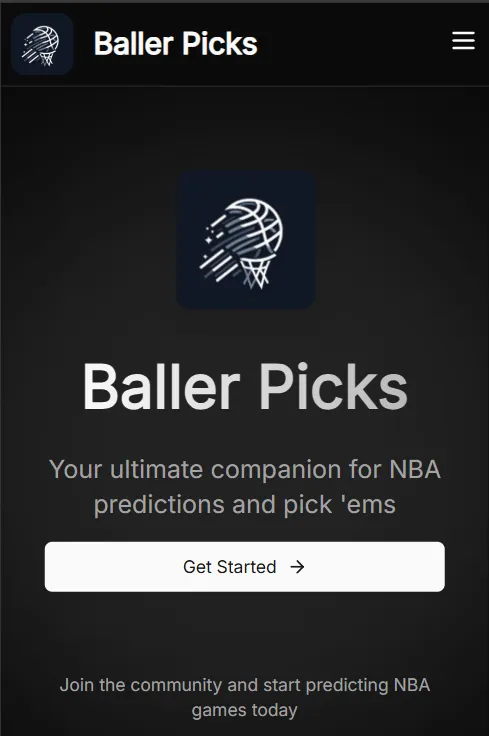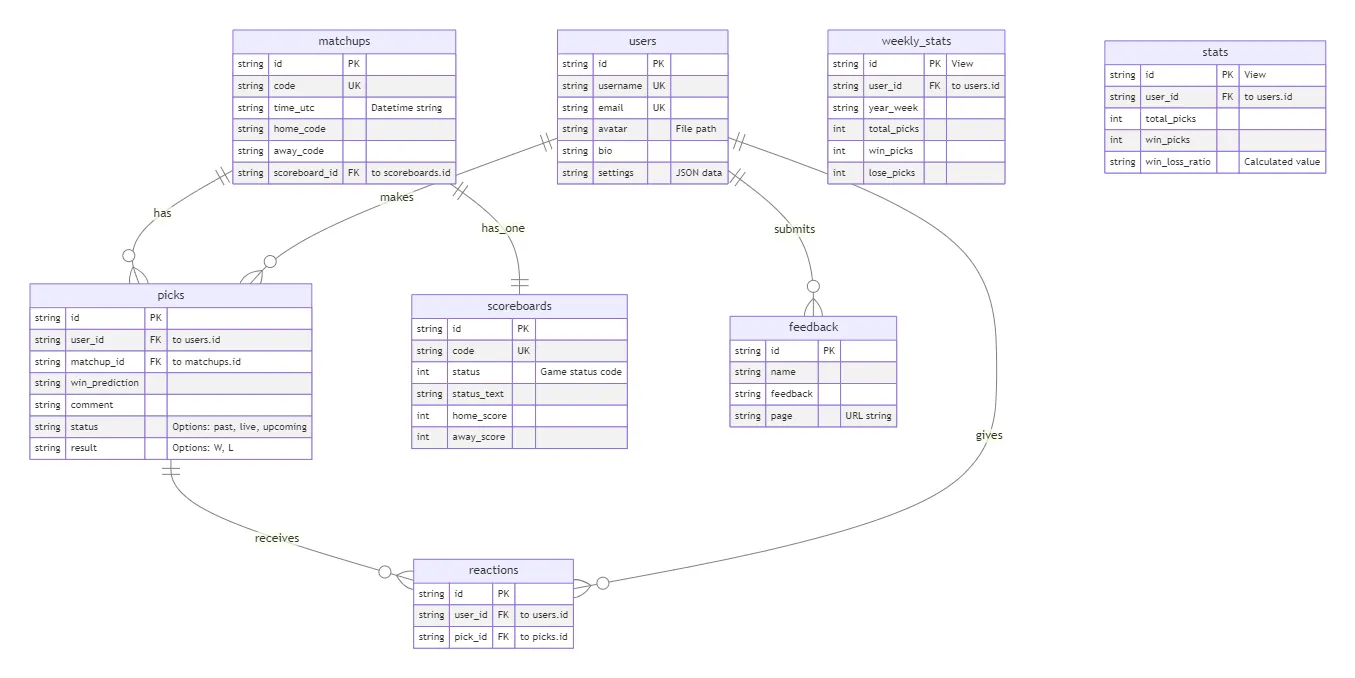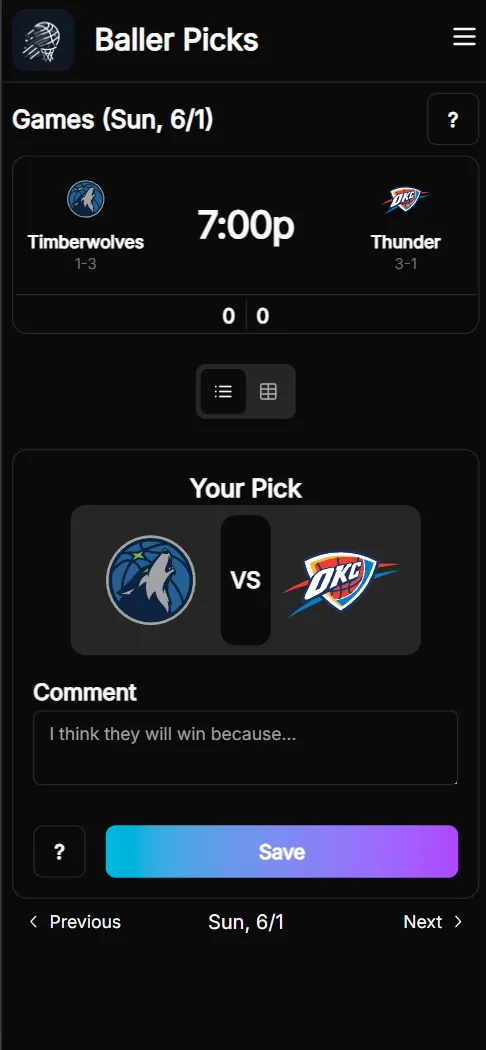
An in-depth look at the process and technology behind creating a full-stack NBA pick’em Progressive Web App.
Table of Contents
Open Table of Contents
Introduction
I built this project with a simple goal in mind: to create a fun way for my friends and me to engage with NBA games. I’ve always enjoyed the friendly competition of predicting outcomes, but I’m not a fan of the high-stakes nature of most gambling apps. I wanted a space focused purely on the love of the game.
The result is Baller Picks, a sophisticated prediction platform that combines the modern web development ecosystem with real-time sports data. In this post, I’ll explore the architecture, technology choices, and implementation details that brought the project to life.
Baller Picks is a comprehensive platform that allows NBA fans (my friends and I) to:
- Predict game outcomes with detailed reasoning and commentary.
- Track performance through statistics and leaderboards.
- Engage with other users’ predictions.
- Stay updated with real-time NBA game data and scores.
- Experience fast, native-like performance through PWA capabilities.
The platform leverages real NBA data, providing users with up-to-date matchup information and team statistics to make informed predictions.

Technology Choices
Choosing the right technology is critical for any project’s success. My goal was to use modern, productive tools that would ensure a high-quality, performant, and maintainable application.
Frontend Architecture
- Astro: Chosen for its excellent performance characteristics, especially its server-side rendering and “island architecture” which minimizes client-side JavaScript.
- React: Used for building interactive UI elements where complex state management is needed.
- TailwindCSS: A utility-first CSS framework that speeds up the styling process immensely.
- ShadCN/UI & Lucide React: A component library and icon set that provide beautiful, accessible UI primitives, allowing for rapid development of a polished interface.
Backend & Database
- PocketBase: An efficient and easy to use backend solution. It handles the database (SQLite), user authentication, and API, which allowed me to focus on the application’s core features.
- Astro Server: Leveraged for server-side rendering (SSR) and creating API routes within the Astro project itself. This server also handles cron jobs to process picks and scoreboard data.
Development & Tooling
- TypeScript: Applied throughout the entire application to ensure type safety from the frontend to the backend.
- Zod: Used for schema declaration and runtime validation, guaranteeing data integrity.
- pnpm: A fast and disk-space-efficient package manager.
State Management & Data Fetching
- Nanostores: A lightweight, framework-agnostic library for sharing state across UI components.
- TanStack Query: Implemented for managing server state, handling caching, and simplifying data fetching logic.
Architecture Deep Dive
The application’s foundation is a well-structured database schema, designed to be both efficient and scalable. I used Zod to define schemas that serve as a single source of truth for data shapes, providing both runtime validation and static TypeScript types.
The schema is centered around three core collections: Users, Matchups, and Picks. The Picks collection is the heart of the system, linking a user to a specific matchup along with their prediction.
Here is the Zod schema for a “Pick”:
TypeScript
// This schema defines the structure for a single prediction
export const PickZ = BaseZ.extend({
matchup: z.string().length(15), // The unique ID of the game
win_prediction: z.string().length(3), // The predicted winning team's code
comment: z.string(), // The user's comment on their pick
user: z.string().length(15), // The user who made the pick
status: z.string(), // The result of the pick (e.g., 'WIN', 'LOSS')
// ...and other relevant fields
});
// This command infers a static TypeScript type from the Zod schema
export type PickType = z.infer<typeof PickZ>;This approach ensures that data conforms to the expected structure throughout the application, from database queries to API responses to frontend components, which significantly reduces runtime errors.
 Entity Relationship Diagram
Entity Relationship Diagram
Key Feature Implementation
Here is a look at how some of the application’s primary features were built.
 matchup interface before the game happens, and no picks are present
matchup interface before the game happens, and no picks are present
 matchup interface after the game has ended and picks are locked
matchup interface after the game has ended and picks are locked
- Real-Time NBA Data Integration
To provide timely and accurate information, the platform automatically synchronizes with an external NBA data source. I wrote a series of cron jobs that run on a schedule to fetch game schedules, team records, and live scoreboard updates. A robust tracking and logging system monitors these jobs to ensure data remains fresh and reliable.
- Progressive Web App (PWA) Capabilities
To provide an experience closer to a native mobile app, Baller Picks was built as a PWA. This includes a service worker for caching strategies and offline access, a web app manifest, and a responsive design optimized for all screen sizes. Users can install the app to their home screen for easy access.

- User Statistics & Performance Tracking
A key feature is the ability for users to track their prediction performance. I developed a system that calculates weekly and overall statistics, such as win/loss ratios and correct pick percentages. These stats are displayed on user profiles and aggregated into a site-wide leaderboard.
 user stats on profile page
user stats on profile page
Key Takeaways
This project was a valuable learning experience. These were some of my most important takeaways:
- End-to-End Type Safety is a Worthwhile Investment: Using Zod and TypeScript across the entire stack created a more resilient application and saved significant debugging time.
- Server-Side Rendering Delivers a Better UX: Astro’s performance-first approach to SSR results in faster initial page loads and a smoother user experience.
- Leveraging a BaaS Can Accelerate Development: Using PocketBase for the backend abstracted away much of the complexity of database and auth management, allowing me to focus on frontend and feature development.
- A Good User Experience is Multifaceted: It’s the combination of a clean UI, fast performance (SSR), and useful features (PWA capabilities) that creates a truly engaging product.
Conclusion
Baller Picks demonstrates a comprehensive approach to building modern web applications. By combining Astro’s server-side rendering with a type-safe backend, the platform delivers strong performance while maintaining developer productivity. It successfully fulfills my initial goal of creating an engaging, data-driven sports application that prioritizes community fun over gambling.
The project showcases how thoughtful technology choices can lead to applications that are both powerful for developers and delightful for users.
For those interested in exploring the implementation further, the project’s codebase demonstrates advanced patterns in Astro, TypeScript integration, and real-time data management. Check it out on my GitHub here